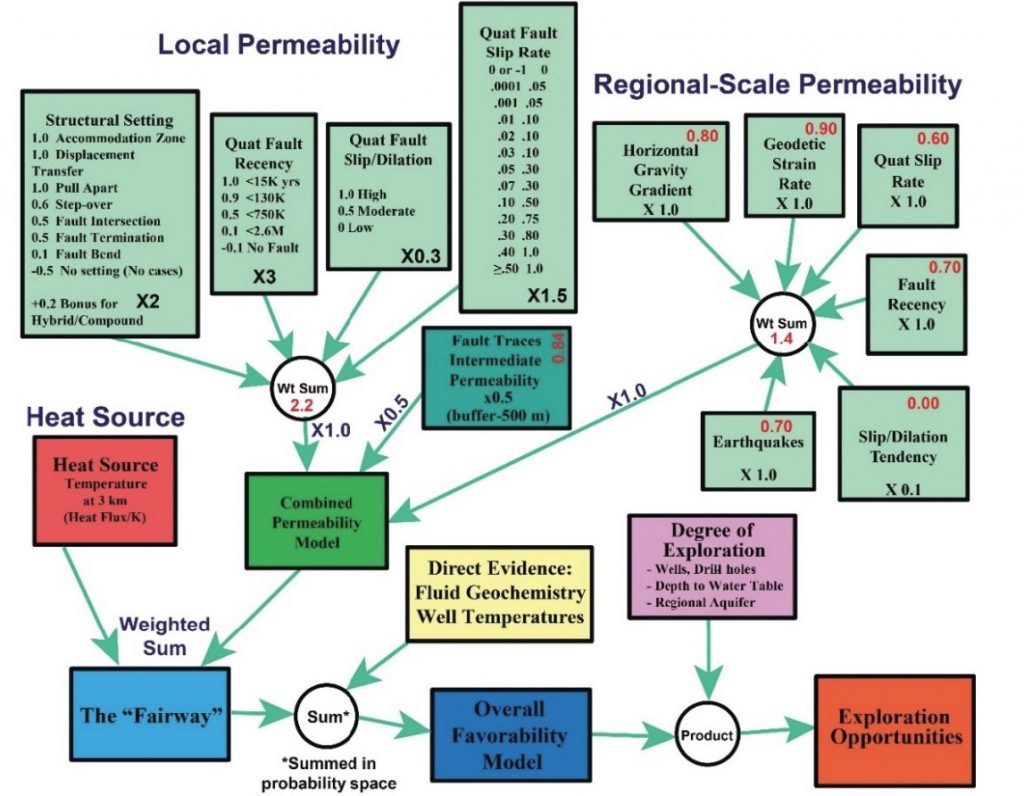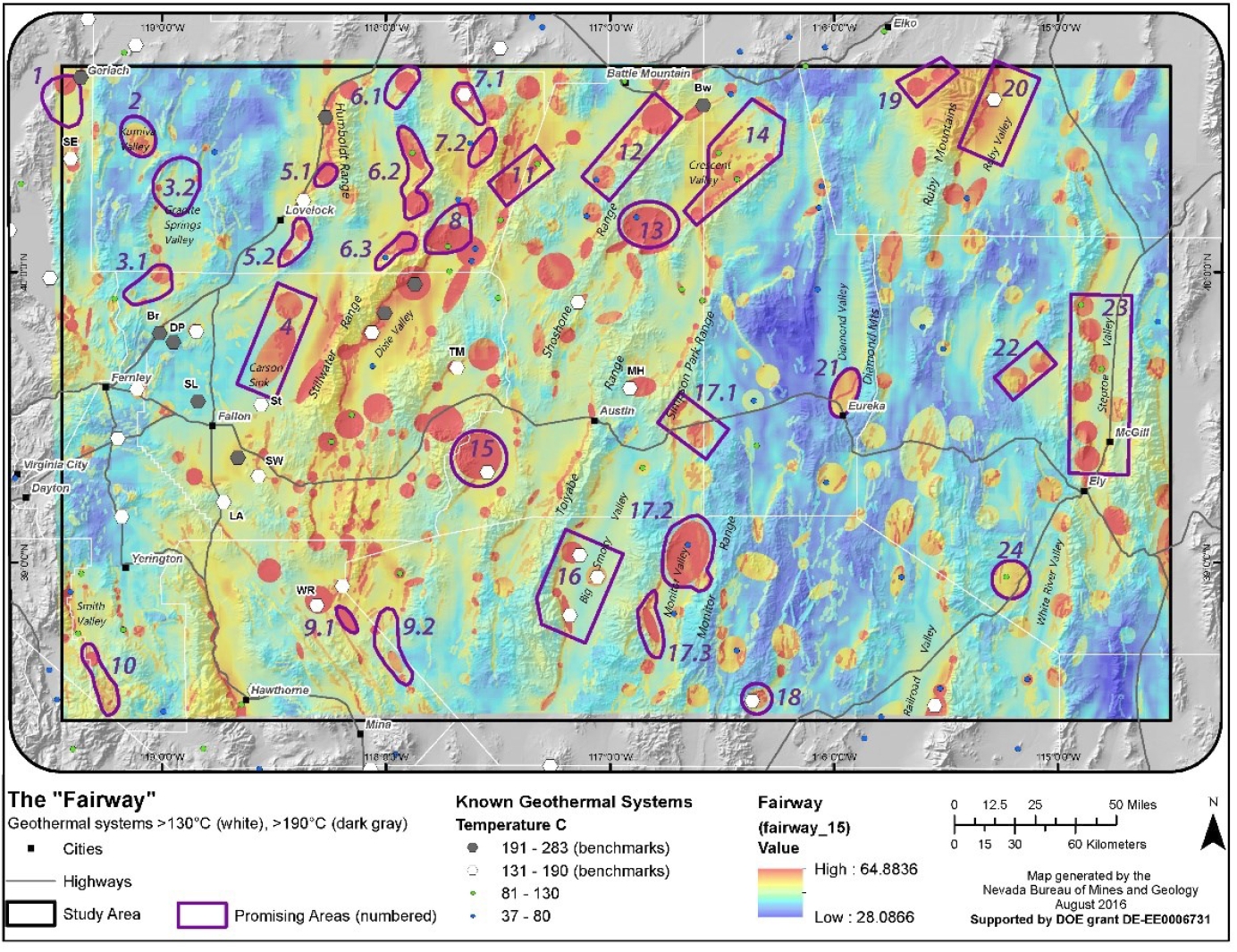Nevada Play Fairway project: Phase 2
GBCGE personnel: Dr. James Faulds (PI), Nicholas Hinz; Dr. Lisa Shevenell; Dr. Mark Coolbaugh; Alan Ramelli; Emma McConville; Jason Craig.
Project duration: 18 months: 1 April 2016 – 30 September 2017.
Funding agency: U.S. Department of Energy (award number DE-EE0006731)
Total federal funding: Phase 2: $825,000
Project accomplishments:
This project aimed to develop a methodology to predict the locations of potential blind hydrothermal geothermal systems (i.e., systems with no surface hot springs or steam vents) and distinguish the most promising systems for development. In Phase 1 of the Nevada play fairway project, an extensive suite of existing geological, geophysical and geochemical data were compiled and evaluated, in support of locating new areas with geothermal potential and developing a workflow to reduce geothermal exploration risk (Faulds et al., 2015a; Faulds et al., 2016). Outputs of Phase 1 included the identification of multiple locations with apparent geothermal resource potential. In Phase 2, 24 sites were prioritized from the Phase 1 results, from which 5 sites were selected for more detailed characterization: Gabbs Valley, Sou Hills, Granite Springs Valley, Crescent Valley, and Steptoe Valley. Key activities for Phase 2 included additional data collection such as shallow temperature surveys, more detailed structural mapping, reprocessing of existing seismic data, geological modeling, and water sampling for geochemical analysis.
Phase 3 of the Nevada Play Fairway project began in October 2017: visit the project page to learn more about our activities.


Project outputs and publications:
McConville, E.G., Faulds, H.E., Hinz, N.H., Ramelli, A.R., Coolbaugh, M.F., Shevenell, L., Siler, D.L., Bourdeau-Hernikl, J., (2017). A Play Fairway Approach to Geothermal Exploration in Crescent Valley, Nevada. Geothermal Resources Council Transactions, Vol. 41. https://www.geothermal-library.org/index.php?mode=pubs&action=view&record=1033796
Craig, J.W., Faulds, J.E., Shevenell, L.A., Hinz, N.H., (2017). Discovery and Analysis of a Potential Blind Geothermal System in Southern Gabbs Valley, Western Nevada. Geothermal Resources Council Transactions, Vol. 41. https://www.geothermal-library.org/index.php?mode=pubs&action=view&record=1033869
Faulds, J.E., et al., (2017). The Nevada Play Fairway Project: An Integrated Approach to Discovering New Geothermal Systems in the Great Basin Region. Geological Society of America (GSA) annual meeting: Seattle, Washington, USA. https://gsa.confex.com/gsa/2017AM/webprogram/Paper307875.html
Faulds, J.E., Hinz, N.H., Coolbaugh, M.F., Sadowski, A., Shevenell, L.A., McConville, E., Craig, J., Siler, D.L., (2017). Progress Report on the Nevada Play Fairway Project: Integrated Geological, Geochemical, and Geophysical Analyses of Possible New Geothermal Systems in the Great Basin Region. Proceedings of the 42nd Stanford Geothermal Workshop. https://www.geothermal-energy.org/cpdb/record_detail.php?id=27895
Faulds, J.E., Hinz, N.H., Coolbaugh, M.F., Shevenell, L.A., (2016). The Nevada Play Fairway Project: Review of Highly Prospective Areas for New Discoveries of Potentially Viable Geothermal Systems in the Great Basin Region, Western USA. Geothermal Resources Council Transactions, Vol. 40. https://www.geothermal-library.org/index.php?mode=pubs&action=view&record=1032368
Faulds, J.E., Hinz, N.H., Coolbaugh, M.F., DePolo, C.M., Siler, D.L., Shevenell, L.A., Hammond, W.C., Kreemer, C., Queen, J.H., (2016). Discovering Geothermal Systems in the Great Basin Region: an Integrated Geologic, Geochemical, and Geophysical Approach for Establishing Geothermal Play Fairways. Proceedings of the 41st Stanford Geothermal Workshop, https://www.geothermal-energy.org/cpdb/record_detail.php?id=26410
